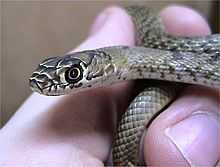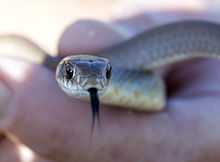Masticophis flagellum
| Masticophis flagellum | |
|---|---|
 | |
| Baby Western coachwhip Masticophis flagellum testaceus | |
| Scientific classification | |
| Kingdom: | Animalia |
| Phylum: | Chordata |
| Subphylum: | Vertebrata |
| Class: | Reptilia |
| Order: | Squamata |
| Suborder: | Serpentes |
| Family: | Colubridae |
| Subfamily: | Colubrinae |
| Genus: | Masticophis |
| Species: | M. flagellum |
| Binomial name | |
| Masticophis flagellum (Shaw, 1802) | |
| Synonyms | |
| |
Masticophis flagellum is a species of nonvenomous colubrid snake, commonly referred to as the coachwhip or the whip snake, which is endemic to the United States and Mexico. Seven subspecies are recognized, including the nominotypical subspecies.
Geographic range
Coachwhips range throughout the southern United States from coast to coast. They are also found in the northern half of Mexico.
Description

Coachwhips are thin-bodied snakes with small heads and large eyes with round pupils. They vary greatly in color, but most reflect a proper camouflage for their natural habitat. M. f. testaceus is typically a shade of light brown with darker brown flecking, but in the western area of Texas, where the soil color is a shade of pink, the coachwhips are also pink in color. M. f. piceus was given its common name because specimens frequently, but not always, have some red in their coloration. Coachwhip scales are patterned so at first glance, the snake appears braided. Subspecies can be difficult to distinguish in areas where their ranges overlap. Adult sizes of 127–183 cm (50–72 in) are common. The record sized specimen, of the Eastern coachwhip race, was 259 cm (102 in).[2] Young specimens, mostly just over 100 cm (39 in) in length, were found to have weighed 180 to 675 g (6.3 to 23.8 oz), whereas good-sized mature adults measuring 163 to 235 cm (64 to 93 in) weighed in at 1.2 to 1.8 kg (2.6 to 4.0 lb).[3][4]
Habitat
Coachwhips are commonly found in open areas with sandy soil, open pine forests, old fields, and prairies. They thrive in sandhill scrub and coastal dunes.
Behavior
Coachwhips are diurnal, and actively hunt and eat lizards, small birds, and rodents. They tend to be sensitive to potential threats, and often bolt at the first sign of one; they are extremely fast-moving snakes. They are curious snakes with good eyesight, and are sometimes seen raising their heads above the level of the grass or rocks to see what is around them.
Subspecies
- Sonoran coachwhip, Masticophis flagellum cingulum Lowe & Woodin, 1954
- Eastern coachwhip, Masticophis flagellum flagellum (Shaw, 1802)
- Baja California coachwhip, Masticophis flagellum fuliginosus (Cope, 1895)
- Lined coachwhip, Masticophis flagellum lineatulus H.M. Smith, 1941
- Red coachwhip (Red racer), Masticophis flagellum piceus (Cope, 1892)
- San Joaquin coachwhip, Masticophis flagellum ruddocki Brattstrom & Warren, 1953
- Western coachwhip, Masticophis flagellum testaceus (Say, 1823)

Myths
The primary myth concerning coachwhips, that they chase people, likely arises from the snake and the person both being frightened, and both just happening to be going the same way to escape. Coachwhips are fast snakes, often moving faster than a human, and thus give an impression of aggression should they move toward the person.
The legend of the hoop snake may refer to the coachwhip snakes.
Another myth of the rural southeastern United States is of a snake that, when disturbed, would chase a person down, wrap him up in its coils, whip him to death with its tail, and then make sure he is dead by sticking its tail up the victim's nose to see if he is still breathing. In actuality, coachwhips are neither constrictors (snakes that dispatch their prey by suffocating with their coils) nor strong enough to overpower a person. Also, they do not whip with their tails, even though their tails are long and look very much like a whips.
Their bites can be painful, but generally are harmless unless they become infected.
References
- ↑ The Reptile Database. www.reptile-database.org.
- ↑ "FLMNH - Eastern Coachwhip (Masticophis flagellum flagellum)". Flmnh.ufl.edu. Retrieved 2012-07-26.
- ↑ Mitrovich, M.J.; J.E. Diffendorfer; R.N.Fisher. (2009).Behavioral Response of the Coachwhip (Masticophis flagellum) to Habitat Fragment Size and Isolation in an Urban Landscape. Journal of Herpetology 43 (4): 646-656.
- ↑ Dodd, C.K., and W.J. Barichivich (2007). "Movements Of Large Snakes (Drymarchon, Masticophis) In North-Central Florida. Florida Scientist 70 (1): 83-94." (PDF). Retrieved 2012-07-26.
External links
| Wikimedia Commons has media related to Masticophis flagellum. |
- Austin Reptile Service, Common Snake Myths
- Species Coluber flagellum at The Reptile Database. Accessed 6 February 2013.
Further reading
- Shaw, G. 1802. General Zoology, or Systematic Natural History, Vol. III., Part II. G. Kearsley. London. vii + pp. 313-615. ("Coluber Flagellum", p. 475.)